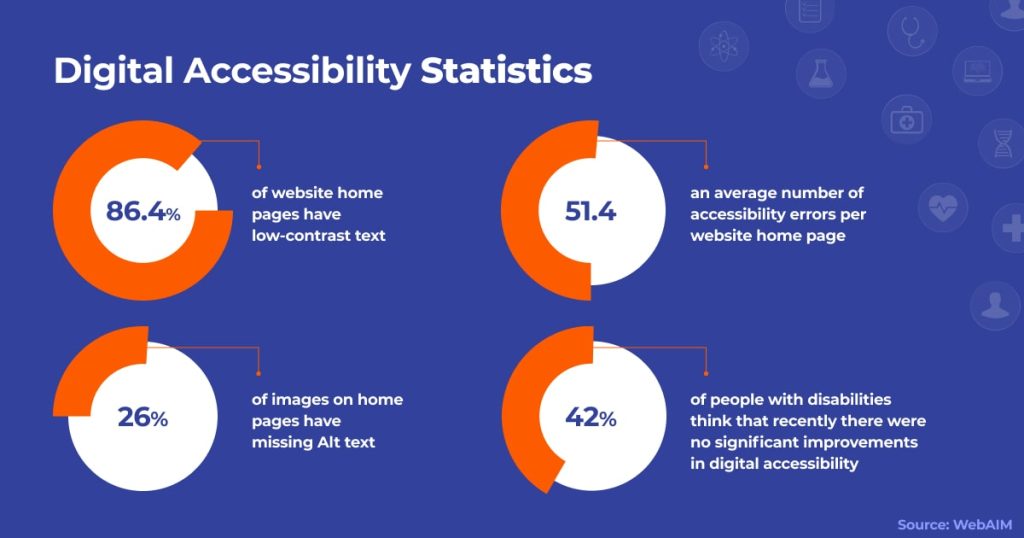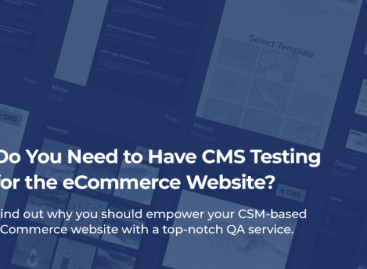- QATestLab Blog >
- QA for Business >
- Industries Insights >
- Universal Care: The Vital Role of Accessibility Testing in Medical Software
Universal Care: The Vital Role of Accessibility Testing in Medical Software

Over the last period of time, our team has been receiving an increasing number of requests to ensure the inclusivity of solutions with the help of specialized accessibility testing. This can be explained by the growing attention and care towards providing an equally comfortable digital experience for people with different abilities. Making a software product more accessible to various categories of users allows businesses to reach a much wider audience, gain trust and ensure a great reputation. These benefits positively influence different aspects, from the position of healthcare websites in browsers to general brand awareness.
In their detailed research called “Compliance and Beyond: 4 Ways Digital Accessibility Gives You a Competitive Advantage”, Gartner stated that digital products achieving full compliance with WGAG Level 2 standards are expected to outperform their competitors by 50%. This is not surprising since broadening software’s user base directly leads to higher conversion rates and increased levels of user satisfaction.
Types of solutions that require special attention to accessibility in order to fulfill their purpose include, of course, medical apps and websites. According to the latest report by the WHO, 1 out of 6 people experience significant disability, and it is clear that such users are most likely to be in need of constant access to high-quality healthcare software. This is why, as developers and owners of medical solutions, you have the power to shape the experience of millions, ensuring that no user is left behind due to inaccessible design.
Join us in exploring how efficient testing can help uplift and maintain the standards of medical software to deliver solutions that are not just innovative but inclusive.
Why Accessibility Is Non-Negotiable for Medical Software?
In fast-paced software development environments, the accessibility aspect can often be overlooked due to tight deadlines, limited budgets, misconceptions about a particular user base, etc. This causes a critical global issue, which lies in the fact that people with disabilities just can’t receive the same quality of services and products as the rest of the population. Take a look at this statistical data revealing a modern state of digital accessibility.

As we can see, there is still a long way to go in terms of ensuring an equally inclusive digital experience for everyone. Although, this cannot happen in the case of medical software. Primarily because of ethical responsibility since medical solutions, at their very core, should be aimed at upholding the principles of equity and inclusivity.
For example, if a disabled user wants to order a product in an online shop but the interface of the website or app is not optimized for them, they can look for another store that provides a better service. However, healthcare solutions are often much more targeted than other types of software. If a person needs a particular type of medical service or looks for medical attention in a specific area, it can only be provided by a very limited number of organizations. This means that sometimes, there might not be an alternative to an inconvenient digital resource, and a user needs to make additional efforts to receive the necessary assistance. In such cases, the only way for a person to resolve the issue may be to visit a provider physically, while typically-abled people can receive the same service much easier and faster online.
Here are a few other reasons why it is critical for healthcare solutions to be accessible:
Legal compliance
Medical software must comply with various laws and regulations, such as the Americans with Disabilities Act (ADA) and the Rehabilitation Act’s Section 508, which mandate accessibility for individuals with disabilities. Non-compliance can result in legal action and fines.
Broader user reach
By making medical software accessible, companies can reach a wider audience, including more than one billion people worldwide with disabilities. This broader reach not only expands the user base but also demonstrates corporate social responsibility.
Improved usability for all
Accessibility features, such as clear navigation and readable fonts, tend to improve the overall user experience for everyone, not just those with disabilities. This can lead to better user satisfaction and increased adoption of the software.
Risk management
Inaccessible software can pose serious risks in medical settings, where accurate and timely access to information is critical. Ensuring accessibility mitigates the risk of miscommunication and errors, therefore improving patient safety.
Market differentiation
Prioritizing accessibility can set a medical software company apart from its competitors, positioning it as a leader in user-centered design and innovation. This can be a significant differentiator in the competitive healthcare technology market.
Cost efficiency
Incorporating accessibility from the start of software development is more cost-effective than addressing it after a product is built. The earlier in the development process you start testing your solution for accessibility, the easier and less expensive it will be to ensure the highest standards.
Global market compliance
As companies expand globally, they must meet the accessibility standards of different countries. Accessible design ensures a smoother transition into international markets, where regulations may be even more strict.
Enhanced reputation
Demonstrating a commitment to accessibility can enhance a company’s reputation, attracting positive attention from consumers, advocacy groups, and the industry at large.
Unique Challenges of Making Medical Software Accessible
Creating inclusive medical software is not an easy feat due to the critical nature of healthcare information and services. Before starting testing activities for your healthcare product, it is important to understand which aspects of your solution require special attention in terms of accessibility. Let’s take a look at the most common issues to focus on during accessibility testing of healthcare software.
- Complexity of medical data
Medical software often involves complex data, which can be challenging to present in an accessible way. Make sure that your product is not overflowing with medical terminology, charts, and graphs. These elements create additional complications for users accessing digital content with screen readers and other assistive technologies. You can also provide at least short explanations of these elements to make this task easier.
- Diverse user base
Patients with a wide range of disabilities and varying levels of tech-savviness must be able to access their health information. This requires a design that is intuitive for all levels of users. Therefore, here, a nice strategy would be to research different types of disabilities and make sure that you take each of them into consideration while testing your solution.
- Color contrast
Medical software often uses complex color schemes, which can make it difficult for visually impaired people to read and understand the content. To avoid this, it is recommended to adhere to the Web Content Accessibility Guidelines (WCAG) and color contrast tools and checkers that can analyze the colors on your software’s interface to ensure they meet the required contrast ratios.
- Privacy and Security
Balancing the need for strong security and privacy with accessibility features is challenging. For instance, CAPTCHAs that protect against spam and abuse may present barriers to individuals with visual impairments. Here, you can use text-based logic questions or CAPTCHAs that use audio alongside visual information to make the user verification process more accessible to individuals with visual impairments. Alternatively, you can utilize Google’s reCAPTCHA v3, which can distinguish between bots and humans without interactive challenges, thus providing an inclusive user experience.
- Emergency and time-sensitive nature
Medical software is often used in emergency situations where time is critical. Ensuring that accessibility features do not slow down the process or hinder immediate access to vital information is essential.
- Mobile accessibility
With the increasing use of mobile devices to access medical software, ensuring that apps are accessible on various devices and operating systems adds another layer of complexity. This is why testing on real gadgets is essential to knowing whether your product is user-friendly and inclusive in real-life scenarios.

Case Study: Boosting Accessibility of a Private Clinic’s Website
We hope that all the information and tips we provided in the previous chapters of this article will be useful in your journey to making your medical software more accessible.
To illustrate the importance and numerous benefits that this QA process brings to healthcare providers and their software in practice, we also prepared a useful case study based on our recent collaboration with a private clinic. Take a look to find out how it went.
Project Overview: The client’s product is a website of a local private clinic. The user base of this website was quite wide and included disabled people. This is why it was important for our client to implement all measures to improve the compliance of their software with international regulations and make it accessible for all types of users in a short period of time.
Implementation: The testing process started by carefully studying all the requirements dictated by the WCAG 2.1 standard and compiling a detailed testing plan to check the website’s compliance with each of them. One of the main issues we detected during accessibility testing was the absence of alternative (Alt) text to describe visual content. It meant that the patients or potential patients of this clinic who had visual impairments and attempted to use Screen Reader to access the content couldn’t do it. Therefore, it was crucial to ensure the proper description of every image on the website, even those that seemed insignificant or obvious to the developers and typically-abled users.
Benefits of accessibility testing for this software:
- the features implemented after accessibility testing were not only useful to people with disabilities but also benefited the rest of the users because the website’s structure became more logical;
- the quality of user experience also increased due to removing bright colors of the text and background and adding the feature of keyboard-only controls;
- the client’s website became compliant with the international standards that regulate this industry, so the organization avoided potential legal issues.

Ensuring Healthcare Equity
Accessibility to medical software is absolutely essential in modern times. Above all the business and legal benefits described in this article, making sure that the content of your medical solution is accessible shows your users that you truly care for them and that your business or organization is committed to delivering healthcare services of the highest quality. This makes accessibility a key to the trust of your users.
The statistics and insights we have shared underscore that there remains a significant gap in the digital accessibility of medical software. Bridging this gap is not an option but a necessity, especially given the criticality of the services these applications and websites provide. As developers and providers, the power to catalyze change lies in our hands. It is time to embrace the challenge and commit to developing solutions that are not just technologically advanced but are also universally accessible.
Let QATestLab help you cope with all the intricacies of the accessibility testing process. Our specialists are well-versed in the standards of the healthcare industry and can provide you with targeted resources to eliminate accessibility issues in your product without delaying your release. Contact our team and let’s make your software inclusive and accessible to all.
Learn more from QATestLab
Related Posts:
- Accessibility Testing: Creating a World Without Walls
- The Importance of Medical Device Software Testing
- Don’t Lose Sales: The Importance of User-Friendly and Accessible Design for an Online Store
About Article Author
view more articles






